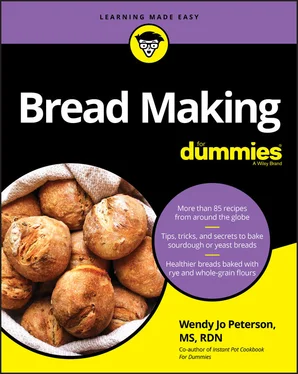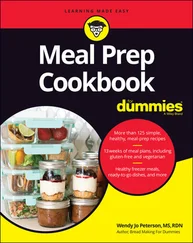Chapter 2
Digging into the Ingredients
IN THIS CHAPTER
 Looking at the different types of flour used in bread making
Looking at the different types of flour used in bread making
 Considering all the other ingredients that go into bread
Considering all the other ingredients that go into bread
The most critical ingredient in bread making is flour. Flour is what gives the bread its structure, texture, and flavor. However, not all flours are created equally. In this chapter, I dive into the differences among various flours, so you can make any recipe, knowing how to swap flours in and out.
Although flours take center stage in bread making, additional ingredients make flour become bread. In this chapter, I walk you through all these other important ingredients — from yeast to salt to liquids and more.
Flours come in all different varieties, from grains to protein. In this section, I look at the flours used most often in bread making. The following list just scratches the surface of flours used in bread making, though, so don’t hesitate to branch out and try different kinds of flour to see which one you like best.
 The type of flour you use in baking matters. Cake flour yields the best cakes, but it’s not what you want to use when making bread.
The type of flour you use in baking matters. Cake flour yields the best cakes, but it’s not what you want to use when making bread.
 ALL YOU EVER WANTED TO KNOW ABOUT WHEAT
ALL YOU EVER WANTED TO KNOW ABOUT WHEAT
In the United States, wheat is grown in 42 of the 50 states. There are six wheat varieties: hard red winter, hard red spring, soft red winter, hard white, soft white, and durum. Technically, wheat is a member of the grass family (hence, the image of golden swaying wheat that may come to mind when you picture wheat).
Whole wheat is a whole grain, meaning it contains all the parts of the grain: the bran, germ, and endosperm. Whole wheat is naturally low in fat and a good source of fiber. It also has important nutrients, such as, selenium, potassium, and magnesium. In the 1990s, wheat products got a boost of nutrition with the enrichment of iron, folic acid, thiamin, riboflavin, and niacin. This came about as a means to combat birth defects and support nutrient deficiencies across the United States.
When the grass of wheat is dried and ground down, it becomes a whole-wheat flour. When the grass is stripped of everything except the endosperm, it becomes white flour. If you’re looking for the most nutrient-dense flours, look for the words stone ground on the label — this old-world grinding technique is slower and helps retain more nutrition than the faster, more conventional techniques used today.
Bread tends to get a bad rap because it’s often made with white and enriched flour instead of the whole-grain form. You can absolutely savor a great white bread, but just remember to balance your plate with whole grains. Also, branch out and try a variety of grains that boost nutrition and flavor in breads.
All-purpose flour: Many cookbooks use the term flour to mean “all-purpose flour.” All-purpose flour contains 10 percent to 12 percent protein. Many manufacturers label their all-purpose flour with the percentage of protein so the consumer understands what they’re using. You can find all-purpose flour bleached or unbleached; for bread making, choose an unbleached flour.
Bread flour: Bread flour typically ranges from 12 percent to 14 percent protein, which is an ideal range for forming gluten and creating the matrix (see Chapter 1).
Cake flour: Cake flour plays a role in certain breads, like Croissants ( Chapter 9) and German Pretzels ( Chapter 9). Cake flour is lower in protein (about 7 percent to 9 percent) than all-purpose flour and it’s milled finer. These simple differences make a significant impact on texture. Although you can swap out cake flour for all-purpose flour, the outcome won’t result in as tender of a crumb.
Whole-wheat flour: Whole-wheat flour contains the bran, germ, and endosperm of wheat and is around 14 percent protein. Whole-wheat flour produces a denser, often less airy or spongy bread. When you know how to work the grain, you can produce a great product with whole-wheat flour.
White whole-wheat flour: A white whole-wheat flour has often been produced from a spring white wheat, so it’s a whole-wheat product and can have a higher protein content (13 percent), but it has a milder flavor.
Winter red wheat flour: Red refers to the color of the kernel of wheat grown. Winter red wheat flour produces a nuttier, more robust wheat flavor. Many artisan bread makers seek out a hard red wheat flour because of the flavor and higher protein (14 percent).
Einkorn: Einkorn means “single grain” in German. Einkorn is the most primitive form of the wheat grain that you can find. Because it’s an ancient grain, it produces a denser bread with a nuttier flavor than you may have tasted before. You can purchase einkorn as a berry, and then mill or sprout it to add it to breads, or you can purchase the flour and add it to your bread recipes. Einkorn has a protein content of 22 percent, but it’s low in gluten. Often, in recipes with ancient grains, you find a gluten product, whether in the form of flour or in vital wheat gluten added to the recipe to help form the matrix in bread.
Emmer: Much like einkorn, emmer is an ancient grain that is high in protein (22 percent) and low in gluten.
Khorasan: Khorasan is an ancient grain that has not been subjected to modern hybridization. At 15 percent protein, it can make a better bread than other ancient grains. It requires more liquid, though, because it absorbs more than other flours do. The grain produces a dense loaf of bread. Some research studies have highlighted the cholesterol-lowering effects of eating more Khorasan grains.
Rye flour: Rye is not a wheat at all, but a grass. Rye is a popular grain used throughout Europe and Russia. It has less gluten than wheat, producing a denser loaf of bread. You see rye flour used frequently in this book to provide a subtle flavor and increase the nutrition profile of the bread.
Semolina flour: Semolina is a durum wheat and hard wheat, which is most commonly seen in pastas. However, when you use semolina in bread making, you get a pale yellow hue in the bread and subtle nutty undertones.
Spelt flour: Spelt is another fabulous ancient grain, and quite possibly my favorite whole grain to use when making bread. Spelt has a higher gluten content, making it a great substitute for whole-wheat flour in recipes with a range of 13 percent to 14 percent total protein.
Sprouted-grain flour: Sprouting wheat grains prior to milling or adding to dough improves digestibility. You can purchase sprouted whole-wheat flours, which typically has 13 percent to 14 percent protein content, and use it to make a great bread. You can also sprout your own grains (see the nearby sidebar), and add the sprouted grains to your bread mix.
Rice flour: You may consider rice flour an odd item on this list, but rice flour is actually an excellent flour to use with sourdough baking — not within the loaf, but in the banneton (a woven or braided basket that helps a loaf hold its shape and creates a desired design on the surface of the dough during its final proofing). Rice flour won’t stick to the bread as it proofs, allowing the bread to easily release from the mold.
Читать дальше

 Looking at the different types of flour used in bread making
Looking at the different types of flour used in bread making The type of flour you use in baking matters. Cake flour yields the best cakes, but it’s not what you want to use when making bread.
The type of flour you use in baking matters. Cake flour yields the best cakes, but it’s not what you want to use when making bread. ALL YOU EVER WANTED TO KNOW ABOUT WHEAT
ALL YOU EVER WANTED TO KNOW ABOUT WHEAT










